Comparative Analysis of Project Management Methodologies
VerifiedAdded on 2021/05/31
|14
|4219
|381
Report
AI Summary
This report provides a comparative analysis of project management methodologies, focusing on Agile and PRINCE2, and their application to different organizational contexts. The report begins with an introduction to project management methodologies and their importance in achieving project objectives. It then presents three case studies of organizations (A, B, and C) and evaluates the suitability of different methodologies for each, based on their specific needs and challenges. Organization A, a technology services company seeking to expand its manufacturing capacity, is best suited for the Agile methodology due to its flexibility and adaptability to complex projects. Organization B, a construction company concerned about financial risks, benefits from the PRINCE2 methodology, which offers staged risk assessment and control. The report provides detailed justifications for each methodology choice, including the strengths and weaknesses of each approach. It also discusses implementation challenges and offers solutions to potential issues, such as communication, stakeholder management, and cultural change. The report concludes by summarizing the key findings and emphasizing the importance of selecting the right project management methodology to ensure project success.
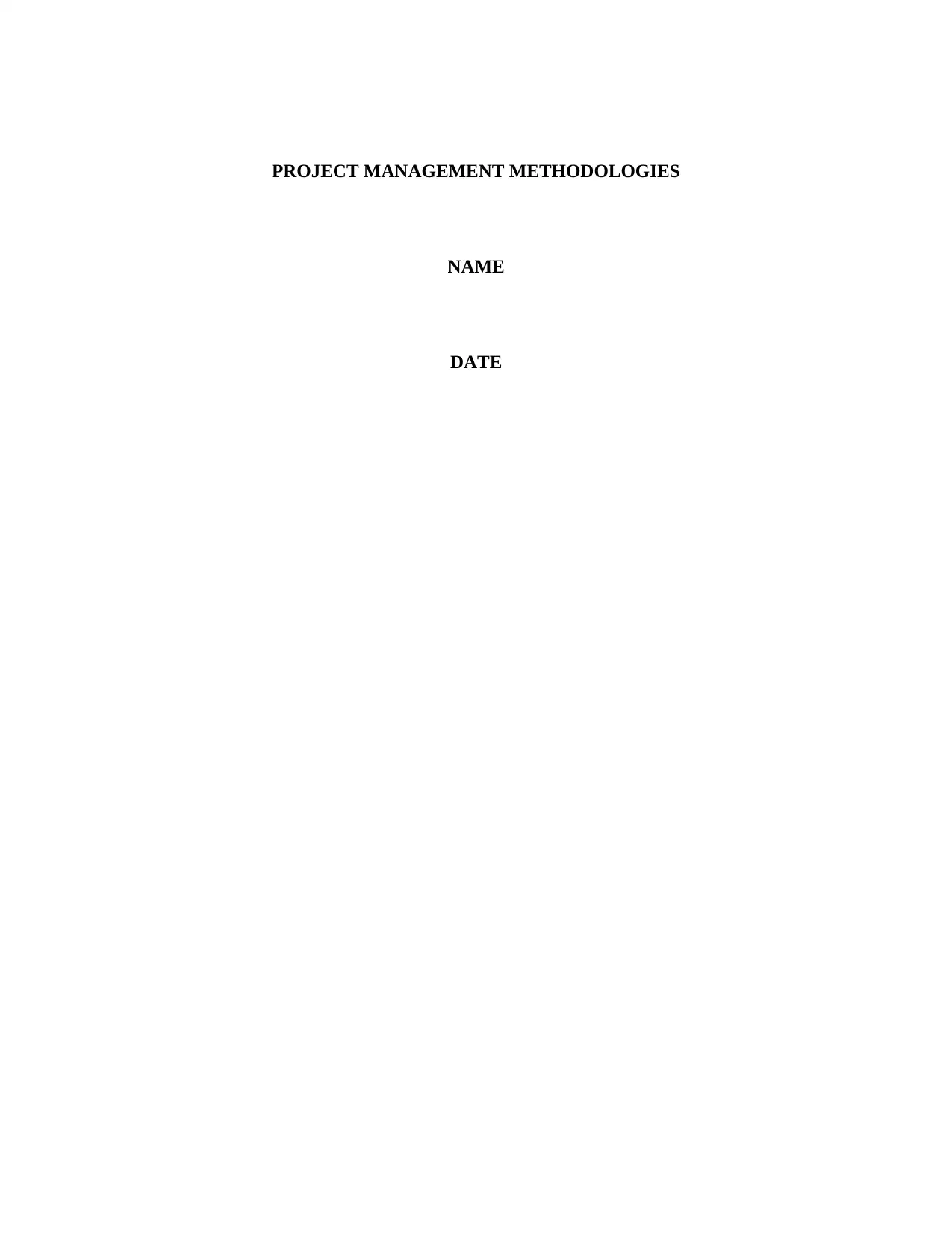
PROJECT MANAGEMENT METHODOLOGIES
NAME
DATE
NAME
DATE
Paraphrase This Document
Need a fresh take? Get an instant paraphrase of this document with our AI Paraphraser
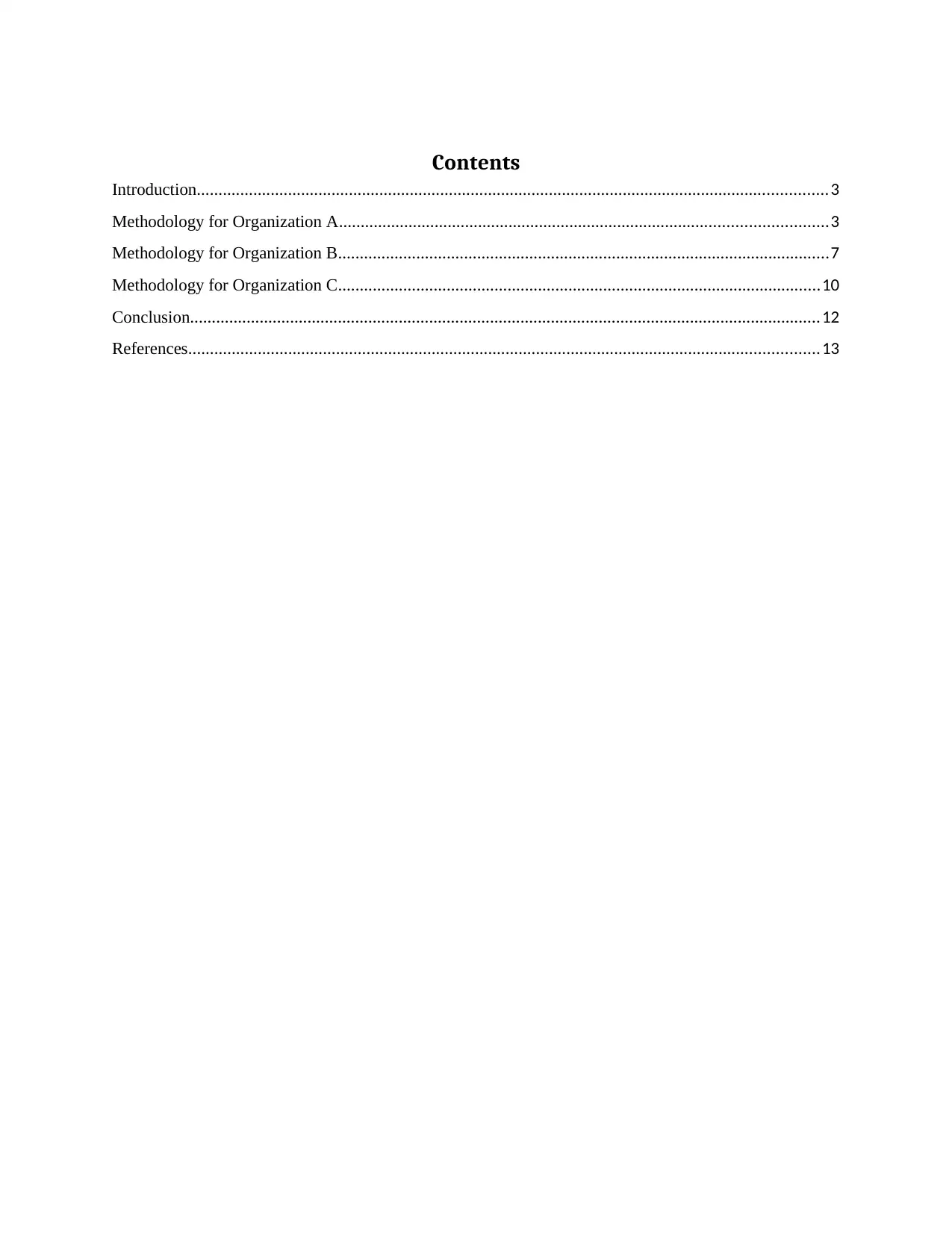
Contents
Introduction.................................................................................................................................................3
Methodology for Organization A................................................................................................................3
Methodology for Organization B.................................................................................................................7
Methodology for Organization C...............................................................................................................10
Conclusion.................................................................................................................................................12
References.................................................................................................................................................13
Introduction.................................................................................................................................................3
Methodology for Organization A................................................................................................................3
Methodology for Organization B.................................................................................................................7
Methodology for Organization C...............................................................................................................10
Conclusion.................................................................................................................................................12
References.................................................................................................................................................13
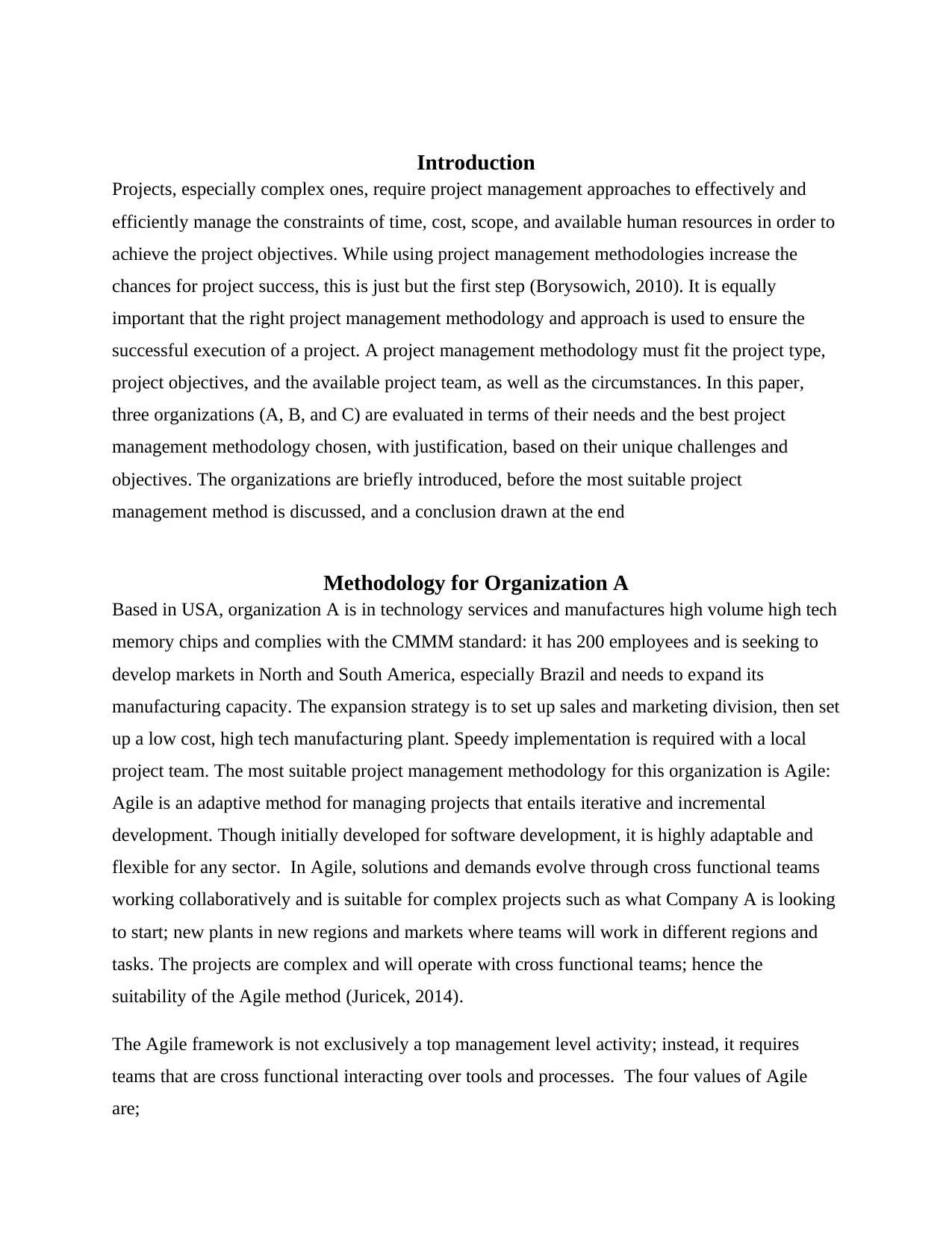
Introduction
Projects, especially complex ones, require project management approaches to effectively and
efficiently manage the constraints of time, cost, scope, and available human resources in order to
achieve the project objectives. While using project management methodologies increase the
chances for project success, this is just but the first step (Borysowich, 2010). It is equally
important that the right project management methodology and approach is used to ensure the
successful execution of a project. A project management methodology must fit the project type,
project objectives, and the available project team, as well as the circumstances. In this paper,
three organizations (A, B, and C) are evaluated in terms of their needs and the best project
management methodology chosen, with justification, based on their unique challenges and
objectives. The organizations are briefly introduced, before the most suitable project
management method is discussed, and a conclusion drawn at the end
Methodology for Organization A
Based in USA, organization A is in technology services and manufactures high volume high tech
memory chips and complies with the CMMM standard: it has 200 employees and is seeking to
develop markets in North and South America, especially Brazil and needs to expand its
manufacturing capacity. The expansion strategy is to set up sales and marketing division, then set
up a low cost, high tech manufacturing plant. Speedy implementation is required with a local
project team. The most suitable project management methodology for this organization is Agile:
Agile is an adaptive method for managing projects that entails iterative and incremental
development. Though initially developed for software development, it is highly adaptable and
flexible for any sector. In Agile, solutions and demands evolve through cross functional teams
working collaboratively and is suitable for complex projects such as what Company A is looking
to start; new plants in new regions and markets where teams will work in different regions and
tasks. The projects are complex and will operate with cross functional teams; hence the
suitability of the Agile method (Juricek, 2014).
The Agile framework is not exclusively a top management level activity; instead, it requires
teams that are cross functional interacting over tools and processes. The four values of Agile
are;
Projects, especially complex ones, require project management approaches to effectively and
efficiently manage the constraints of time, cost, scope, and available human resources in order to
achieve the project objectives. While using project management methodologies increase the
chances for project success, this is just but the first step (Borysowich, 2010). It is equally
important that the right project management methodology and approach is used to ensure the
successful execution of a project. A project management methodology must fit the project type,
project objectives, and the available project team, as well as the circumstances. In this paper,
three organizations (A, B, and C) are evaluated in terms of their needs and the best project
management methodology chosen, with justification, based on their unique challenges and
objectives. The organizations are briefly introduced, before the most suitable project
management method is discussed, and a conclusion drawn at the end
Methodology for Organization A
Based in USA, organization A is in technology services and manufactures high volume high tech
memory chips and complies with the CMMM standard: it has 200 employees and is seeking to
develop markets in North and South America, especially Brazil and needs to expand its
manufacturing capacity. The expansion strategy is to set up sales and marketing division, then set
up a low cost, high tech manufacturing plant. Speedy implementation is required with a local
project team. The most suitable project management methodology for this organization is Agile:
Agile is an adaptive method for managing projects that entails iterative and incremental
development. Though initially developed for software development, it is highly adaptable and
flexible for any sector. In Agile, solutions and demands evolve through cross functional teams
working collaboratively and is suitable for complex projects such as what Company A is looking
to start; new plants in new regions and markets where teams will work in different regions and
tasks. The projects are complex and will operate with cross functional teams; hence the
suitability of the Agile method (Juricek, 2014).
The Agile framework is not exclusively a top management level activity; instead, it requires
teams that are cross functional interacting over tools and processes. The four values of Agile
are;
⊘ This is a preview!⊘
Do you want full access?
Subscribe today to unlock all pages.

Trusted by 1+ million students worldwide
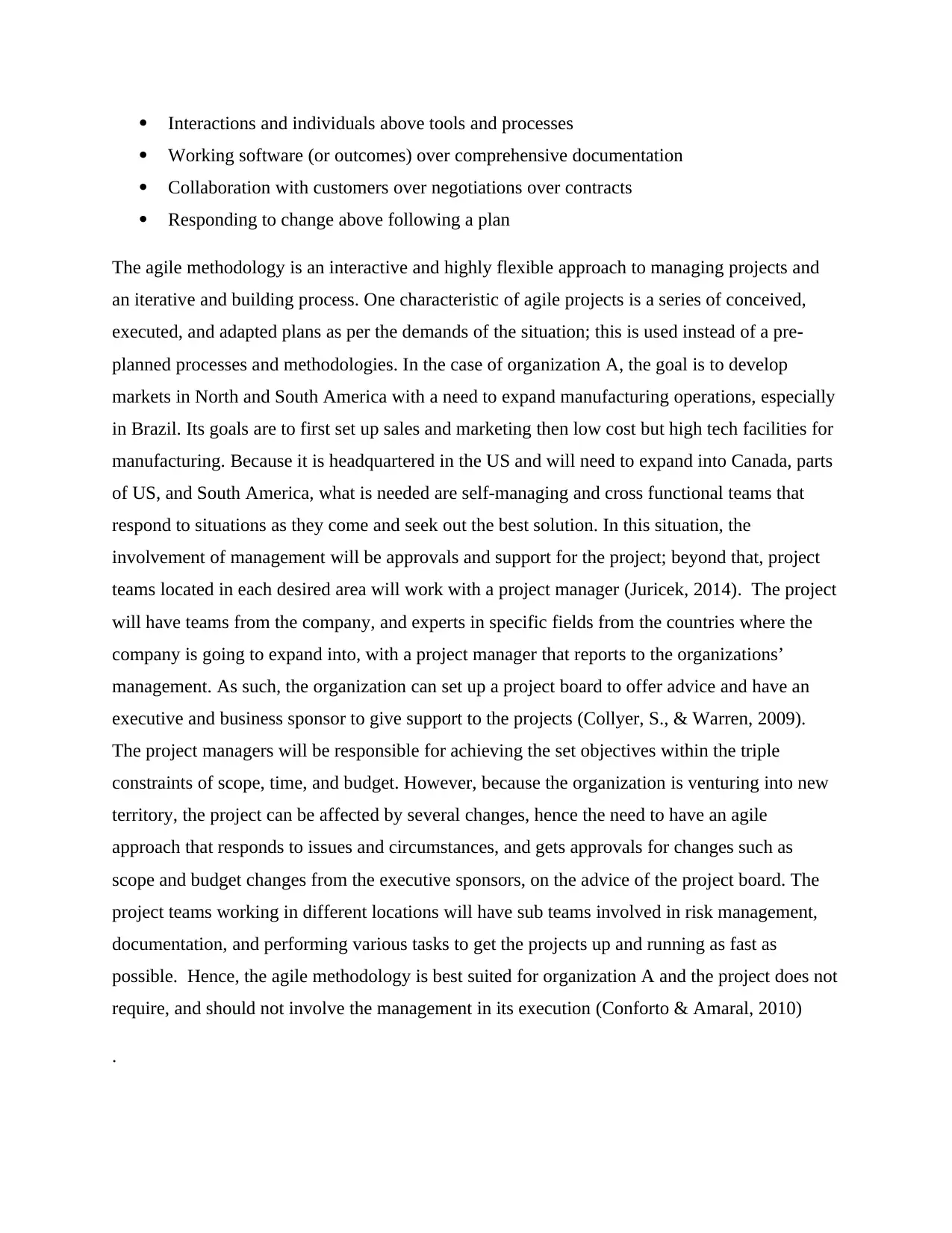
Interactions and individuals above tools and processes
Working software (or outcomes) over comprehensive documentation
Collaboration with customers over negotiations over contracts
Responding to change above following a plan
The agile methodology is an interactive and highly flexible approach to managing projects and
an iterative and building process. One characteristic of agile projects is a series of conceived,
executed, and adapted plans as per the demands of the situation; this is used instead of a pre-
planned processes and methodologies. In the case of organization A, the goal is to develop
markets in North and South America with a need to expand manufacturing operations, especially
in Brazil. Its goals are to first set up sales and marketing then low cost but high tech facilities for
manufacturing. Because it is headquartered in the US and will need to expand into Canada, parts
of US, and South America, what is needed are self-managing and cross functional teams that
respond to situations as they come and seek out the best solution. In this situation, the
involvement of management will be approvals and support for the project; beyond that, project
teams located in each desired area will work with a project manager (Juricek, 2014). The project
will have teams from the company, and experts in specific fields from the countries where the
company is going to expand into, with a project manager that reports to the organizations’
management. As such, the organization can set up a project board to offer advice and have an
executive and business sponsor to give support to the projects (Collyer, S., & Warren, 2009).
The project managers will be responsible for achieving the set objectives within the triple
constraints of scope, time, and budget. However, because the organization is venturing into new
territory, the project can be affected by several changes, hence the need to have an agile
approach that responds to issues and circumstances, and gets approvals for changes such as
scope and budget changes from the executive sponsors, on the advice of the project board. The
project teams working in different locations will have sub teams involved in risk management,
documentation, and performing various tasks to get the projects up and running as fast as
possible. Hence, the agile methodology is best suited for organization A and the project does not
require, and should not involve the management in its execution (Conforto & Amaral, 2010)
.
Working software (or outcomes) over comprehensive documentation
Collaboration with customers over negotiations over contracts
Responding to change above following a plan
The agile methodology is an interactive and highly flexible approach to managing projects and
an iterative and building process. One characteristic of agile projects is a series of conceived,
executed, and adapted plans as per the demands of the situation; this is used instead of a pre-
planned processes and methodologies. In the case of organization A, the goal is to develop
markets in North and South America with a need to expand manufacturing operations, especially
in Brazil. Its goals are to first set up sales and marketing then low cost but high tech facilities for
manufacturing. Because it is headquartered in the US and will need to expand into Canada, parts
of US, and South America, what is needed are self-managing and cross functional teams that
respond to situations as they come and seek out the best solution. In this situation, the
involvement of management will be approvals and support for the project; beyond that, project
teams located in each desired area will work with a project manager (Juricek, 2014). The project
will have teams from the company, and experts in specific fields from the countries where the
company is going to expand into, with a project manager that reports to the organizations’
management. As such, the organization can set up a project board to offer advice and have an
executive and business sponsor to give support to the projects (Collyer, S., & Warren, 2009).
The project managers will be responsible for achieving the set objectives within the triple
constraints of scope, time, and budget. However, because the organization is venturing into new
territory, the project can be affected by several changes, hence the need to have an agile
approach that responds to issues and circumstances, and gets approvals for changes such as
scope and budget changes from the executive sponsors, on the advice of the project board. The
project teams working in different locations will have sub teams involved in risk management,
documentation, and performing various tasks to get the projects up and running as fast as
possible. Hence, the agile methodology is best suited for organization A and the project does not
require, and should not involve the management in its execution (Conforto & Amaral, 2010)
.
Paraphrase This Document
Need a fresh take? Get an instant paraphrase of this document with our AI Paraphraser

The agile methodology should be adopted and implemented in its entirety; this is because Agile
is not strictly a methodology, but a framework with various principles to guide the execution of
the project, with the ultimate goal being whatever works. This means planning, execution, and
evaluation is done continuously as the project proceeds; so that evaluations are made after every
milestone is reached and lessons learned incorporated in the next phase of the project. The
method should be used in Toto because the expansion project does not have issues that can be
easily predicted. However, through effective communication and collaboration, issues can be
solved as they come (Fernandez, 2008).
While it is highly flexible and adaptive, agile does not solve all problems, and will face various
issues and challenges. The most important issues are categorized broadly as communication,
management of day to day problems related to operations, gaining buy in from customers,
management, and project team members, changing mindset and culture, and gaining from
experience and ensuring it works (Miller, 2013).
The difficulties encountered can be addressed as shown in the table below;
Issue Solution(s)
Communication Develop an effective communication plan detailing what to
communicate, to who, how, and through what method, as well as the
responsible person
Day to day operational
problems
Use a method such as SCRUM where daily meetings are held,
achievements discussed, and problems and challenges discussed; a
scrum master will be there to ensure all obstacles are removed and
there is harmony (Miller, 2013).
Buy in from customers,
management, and team
members
Effective project planning
Effective stakeholder management (Miller, 2013).
Changing mindset and
culture
Make initial plans and get an agile coach to familiarize team
members with the method
Use effective change management processes
Select team members with skills and experience in Agile methods
is not strictly a methodology, but a framework with various principles to guide the execution of
the project, with the ultimate goal being whatever works. This means planning, execution, and
evaluation is done continuously as the project proceeds; so that evaluations are made after every
milestone is reached and lessons learned incorporated in the next phase of the project. The
method should be used in Toto because the expansion project does not have issues that can be
easily predicted. However, through effective communication and collaboration, issues can be
solved as they come (Fernandez, 2008).
While it is highly flexible and adaptive, agile does not solve all problems, and will face various
issues and challenges. The most important issues are categorized broadly as communication,
management of day to day problems related to operations, gaining buy in from customers,
management, and project team members, changing mindset and culture, and gaining from
experience and ensuring it works (Miller, 2013).
The difficulties encountered can be addressed as shown in the table below;
Issue Solution(s)
Communication Develop an effective communication plan detailing what to
communicate, to who, how, and through what method, as well as the
responsible person
Day to day operational
problems
Use a method such as SCRUM where daily meetings are held,
achievements discussed, and problems and challenges discussed; a
scrum master will be there to ensure all obstacles are removed and
there is harmony (Miller, 2013).
Buy in from customers,
management, and team
members
Effective project planning
Effective stakeholder management (Miller, 2013).
Changing mindset and
culture
Make initial plans and get an agile coach to familiarize team
members with the method
Use effective change management processes
Select team members with skills and experience in Agile methods
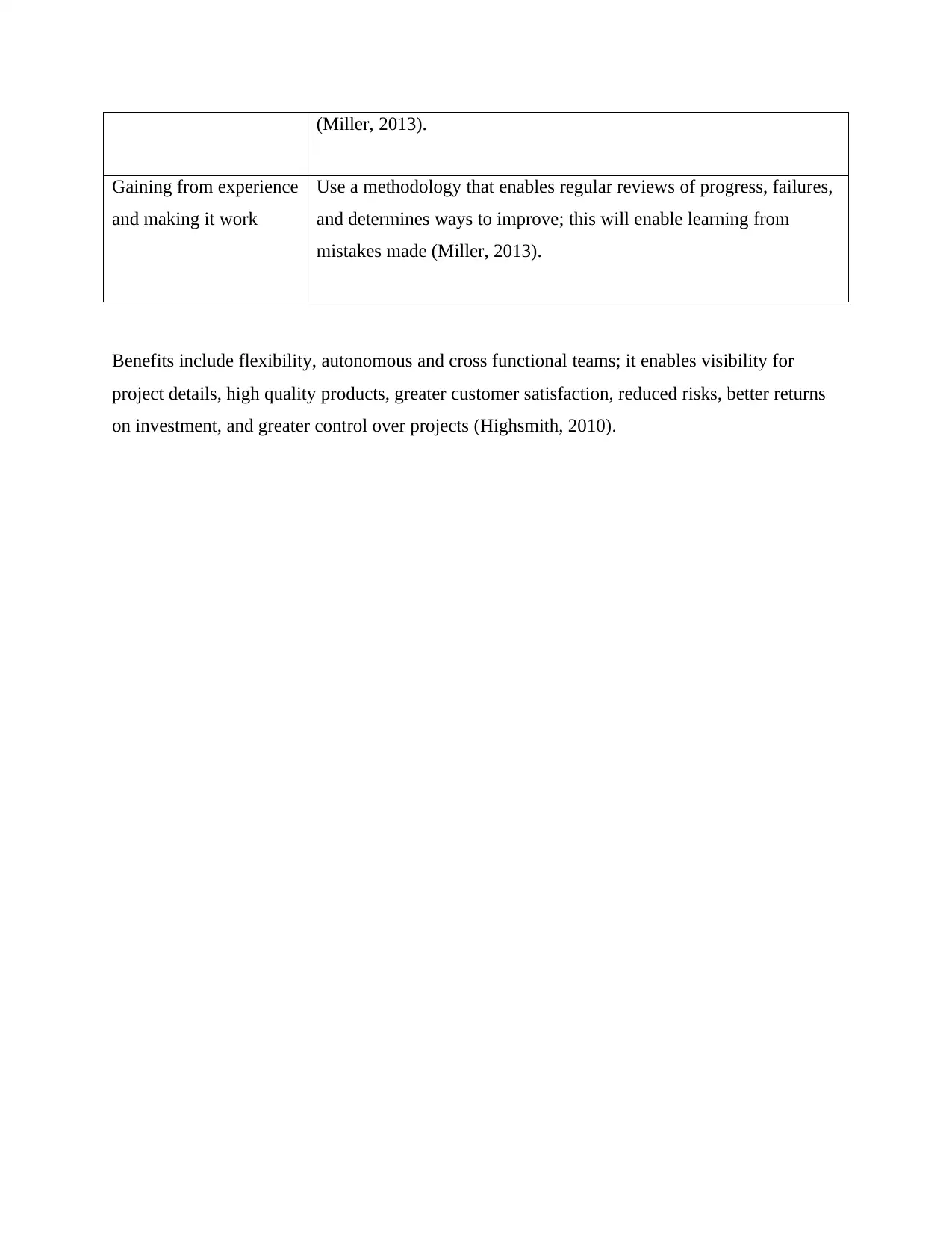
(Miller, 2013).
Gaining from experience
and making it work
Use a methodology that enables regular reviews of progress, failures,
and determines ways to improve; this will enable learning from
mistakes made (Miller, 2013).
Benefits include flexibility, autonomous and cross functional teams; it enables visibility for
project details, high quality products, greater customer satisfaction, reduced risks, better returns
on investment, and greater control over projects (Highsmith, 2010).
Gaining from experience
and making it work
Use a methodology that enables regular reviews of progress, failures,
and determines ways to improve; this will enable learning from
mistakes made (Miller, 2013).
Benefits include flexibility, autonomous and cross functional teams; it enables visibility for
project details, high quality products, greater customer satisfaction, reduced risks, better returns
on investment, and greater control over projects (Highsmith, 2010).
⊘ This is a preview!⊘
Do you want full access?
Subscribe today to unlock all pages.

Trusted by 1+ million students worldwide
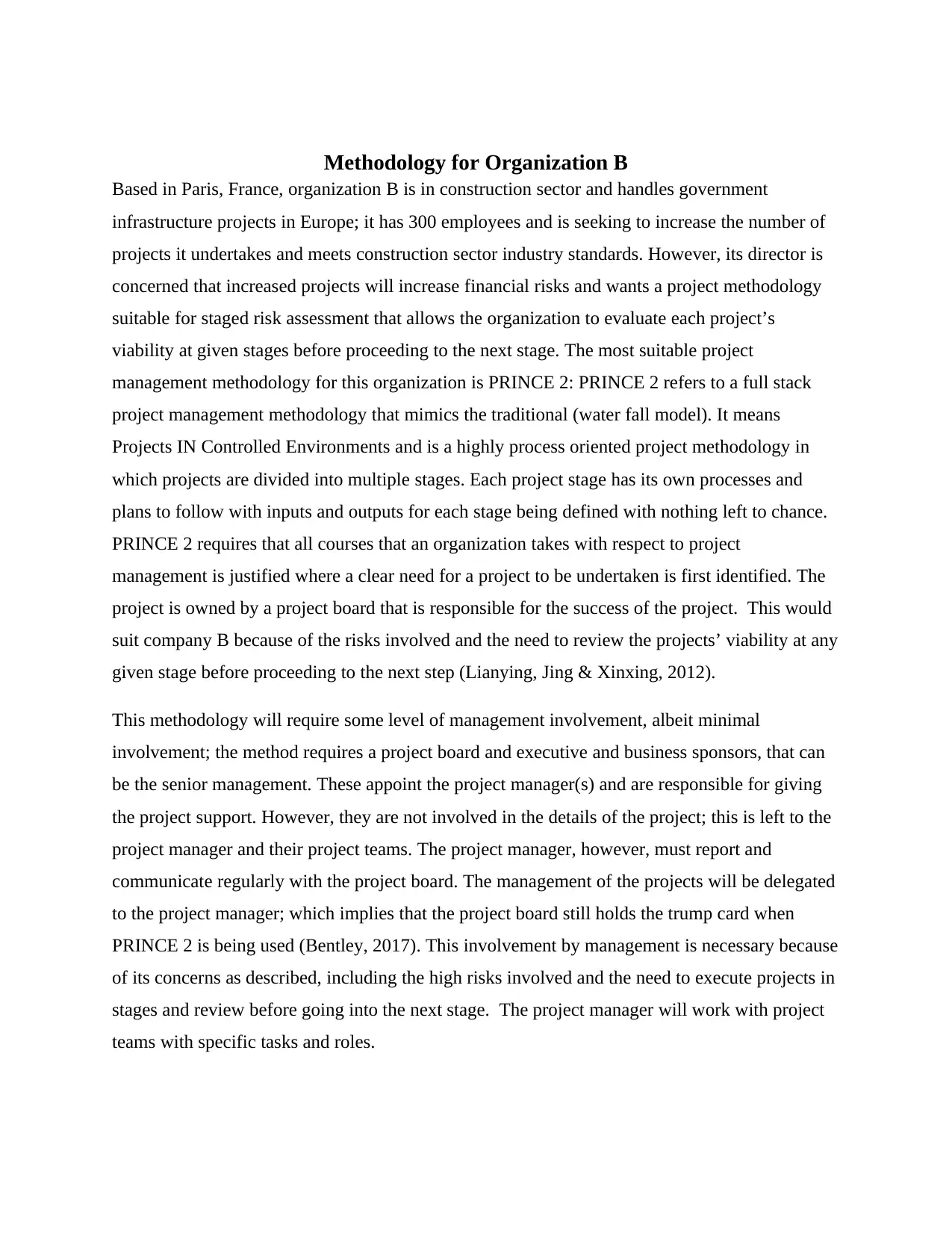
Methodology for Organization B
Based in Paris, France, organization B is in construction sector and handles government
infrastructure projects in Europe; it has 300 employees and is seeking to increase the number of
projects it undertakes and meets construction sector industry standards. However, its director is
concerned that increased projects will increase financial risks and wants a project methodology
suitable for staged risk assessment that allows the organization to evaluate each project’s
viability at given stages before proceeding to the next stage. The most suitable project
management methodology for this organization is PRINCE 2: PRINCE 2 refers to a full stack
project management methodology that mimics the traditional (water fall model). It means
Projects IN Controlled Environments and is a highly process oriented project methodology in
which projects are divided into multiple stages. Each project stage has its own processes and
plans to follow with inputs and outputs for each stage being defined with nothing left to chance.
PRINCE 2 requires that all courses that an organization takes with respect to project
management is justified where a clear need for a project to be undertaken is first identified. The
project is owned by a project board that is responsible for the success of the project. This would
suit company B because of the risks involved and the need to review the projects’ viability at any
given stage before proceeding to the next step (Lianying, Jing & Xinxing, 2012).
This methodology will require some level of management involvement, albeit minimal
involvement; the method requires a project board and executive and business sponsors, that can
be the senior management. These appoint the project manager(s) and are responsible for giving
the project support. However, they are not involved in the details of the project; this is left to the
project manager and their project teams. The project manager, however, must report and
communicate regularly with the project board. The management of the projects will be delegated
to the project manager; which implies that the project board still holds the trump card when
PRINCE 2 is being used (Bentley, 2017). This involvement by management is necessary because
of its concerns as described, including the high risks involved and the need to execute projects in
stages and review before going into the next stage. The project manager will work with project
teams with specific tasks and roles.
Based in Paris, France, organization B is in construction sector and handles government
infrastructure projects in Europe; it has 300 employees and is seeking to increase the number of
projects it undertakes and meets construction sector industry standards. However, its director is
concerned that increased projects will increase financial risks and wants a project methodology
suitable for staged risk assessment that allows the organization to evaluate each project’s
viability at given stages before proceeding to the next stage. The most suitable project
management methodology for this organization is PRINCE 2: PRINCE 2 refers to a full stack
project management methodology that mimics the traditional (water fall model). It means
Projects IN Controlled Environments and is a highly process oriented project methodology in
which projects are divided into multiple stages. Each project stage has its own processes and
plans to follow with inputs and outputs for each stage being defined with nothing left to chance.
PRINCE 2 requires that all courses that an organization takes with respect to project
management is justified where a clear need for a project to be undertaken is first identified. The
project is owned by a project board that is responsible for the success of the project. This would
suit company B because of the risks involved and the need to review the projects’ viability at any
given stage before proceeding to the next step (Lianying, Jing & Xinxing, 2012).
This methodology will require some level of management involvement, albeit minimal
involvement; the method requires a project board and executive and business sponsors, that can
be the senior management. These appoint the project manager(s) and are responsible for giving
the project support. However, they are not involved in the details of the project; this is left to the
project manager and their project teams. The project manager, however, must report and
communicate regularly with the project board. The management of the projects will be delegated
to the project manager; which implies that the project board still holds the trump card when
PRINCE 2 is being used (Bentley, 2017). This involvement by management is necessary because
of its concerns as described, including the high risks involved and the need to execute projects in
stages and review before going into the next stage. The project manager will work with project
teams with specific tasks and roles.
Paraphrase This Document
Need a fresh take? Get an instant paraphrase of this document with our AI Paraphraser

The PRINCE 2 methodology is characterized by high levels of control and so must be
implemented fully; this is because the management of organization B feel that the new project
has high financial risks and there is need to evaluate progress at each stage before moving on to
the next stage. The project plan starts with setting objectives which is then broken down into
smaller objectives to cover the things that need to be done for its achievement. The plan then
evolves to planning backwards from the desired end product (objective) to ensure the timings are
gotten right (Wells, 2012). The timings and milestones are then reviewed to ensure the tasks are
correctly ordered based on dependencies. After this, a budget is developed using accurate
costing methods; this stage marks a milestone in that a high level plan has been developed. A
decision is then made on what should be done in the first period (say two months) and this forms
the first stage. Subsequent stages are then determined to develop an implementation plan that
follows the set stages. Roles are then allocated and this methodology requires continuous
planning at every stage, as changes may be made based on experience and input from the
management, especially with regard to cost and scope (Lianying, Jing & Xinxing, 2012).
The method has its roots in the UK public sector, including on the people that constitute the
project board. Project managers play more of a reporting role with their duties being delegated
by the project board, yet projects need strong leadership to be successful (where leadership
focuses on the project manager). It lacks inbuilt guidelines of budgeting and management of
costs. It is heavy in the business case and justification and not on strategy for delivery. Works
on an assumption that once initiated, the project will proceed ‘according to plan’. It requires
management by exception meaning project managers are made to believe success is not their
responsibility. It is suitable for project initiation and not delivery (Litten, 2017)
Solutions to issues
The main issue with PRINCE 2 for such a project are the inhernet deficiencies in the methd
itself; for instance management by exception, delegated authority to the project manager, and
lack of a cost management and budgeting method, as well as being based on the UK public
service. These issues can be solved by using a hybrid approach to the project, such as combining
PRINCE 2 with an Agile methodology. This is because PRINCE 2 is suitable as a framework for
initiating projects and ensuring tight control; but because of the reality or projects, such as that
projects hardly ever proceed according to plan, Agile methods will enable the project manager to
implemented fully; this is because the management of organization B feel that the new project
has high financial risks and there is need to evaluate progress at each stage before moving on to
the next stage. The project plan starts with setting objectives which is then broken down into
smaller objectives to cover the things that need to be done for its achievement. The plan then
evolves to planning backwards from the desired end product (objective) to ensure the timings are
gotten right (Wells, 2012). The timings and milestones are then reviewed to ensure the tasks are
correctly ordered based on dependencies. After this, a budget is developed using accurate
costing methods; this stage marks a milestone in that a high level plan has been developed. A
decision is then made on what should be done in the first period (say two months) and this forms
the first stage. Subsequent stages are then determined to develop an implementation plan that
follows the set stages. Roles are then allocated and this methodology requires continuous
planning at every stage, as changes may be made based on experience and input from the
management, especially with regard to cost and scope (Lianying, Jing & Xinxing, 2012).
The method has its roots in the UK public sector, including on the people that constitute the
project board. Project managers play more of a reporting role with their duties being delegated
by the project board, yet projects need strong leadership to be successful (where leadership
focuses on the project manager). It lacks inbuilt guidelines of budgeting and management of
costs. It is heavy in the business case and justification and not on strategy for delivery. Works
on an assumption that once initiated, the project will proceed ‘according to plan’. It requires
management by exception meaning project managers are made to believe success is not their
responsibility. It is suitable for project initiation and not delivery (Litten, 2017)
Solutions to issues
The main issue with PRINCE 2 for such a project are the inhernet deficiencies in the methd
itself; for instance management by exception, delegated authority to the project manager, and
lack of a cost management and budgeting method, as well as being based on the UK public
service. These issues can be solved by using a hybrid approach to the project, such as combining
PRINCE 2 with an Agile methodology. This is because PRINCE 2 is suitable as a framework for
initiating projects and ensuring tight control; but because of the reality or projects, such as that
projects hardly ever proceed according to plan, Agile methods will enable the project manager to

respond best to situations and budgeting and cost management will be more effective (Litten,
2017).
The benefits of PRINCE 2 include being flexible enough to be used for any project in any
industry: it’s flexible in that it is not proprietary and is based on best practices rather than rigid
processes. It is a widely recognized methodology with common vocabulary. It is designed for
uncertainty such as problems in organizations or external factors such as recessions (Bentley,
2017)
2017).
The benefits of PRINCE 2 include being flexible enough to be used for any project in any
industry: it’s flexible in that it is not proprietary and is based on best practices rather than rigid
processes. It is a widely recognized methodology with common vocabulary. It is designed for
uncertainty such as problems in organizations or external factors such as recessions (Bentley,
2017)
⊘ This is a preview!⊘
Do you want full access?
Subscribe today to unlock all pages.

Trusted by 1+ million students worldwide

Methodology for Organization C
This is an established financial services company with 11 years’ experience with 800 employees
based in Australia: its business model is successful and complies with the Australian Prudential
Regulation Authority, but looking to make improvements. Its senior management team, created
through internal promotion and professional development is highly motivated and enthusiastic
and always seeking new ideas to challenge the organizations’ status quo. They operate with a
mindset of continuous improvement and support any initiatives that can result in holistic
improvements and are seeking a suitable methodology to meet this objective. The most suitable
project management methodology for this organization is the DMAIC method of project
management. DMAIC forms part of Six Sigma, although it is used as a standalone project
management methodology. This is a data driven methodology with improvement cycles used for
improving, optimizing, and stabilization of business designs and processes. In define; the
customers are clearly defined as well as their needs, with the scope and purpose of the project
also defined, as well as current processes and what customers need from them. In measure; the
performance of the current process is measured with data collected in how current processes
meet customer needs. In analyze; the most significant problem causes are identified, with a focus
on the root causes. In improve; the focus is on removing problem causes and it requires solutions
to be planned, tested, and implemented. In control; focus is on how improvements can be made
and gains made are maintained through standardization of processes and methods (de Mast and
Lokkerbol, 2012). This suits organization C because already, they have working processes and
solutions, but have highly motivated management that is enthusiastic and always looking for
opportunities for making improvements. This approach enables evaluation of existing processes
and methods Vis a Vis customer needs and enables new ideas to be developed, tested, and
implemented (Berardinelli, 2012)
The DMAIC is a management level activity; the management of organization C can initiate the
plan and use it to enable members of the organization contributes ideas that are then tested and
implemented. While the management should be involved, the other members of the organization
should also be more involved, such that the management becomes the initiators and supporters to
the project using DMAIC (de Mast and Lokkerbol, 2012).
This is an established financial services company with 11 years’ experience with 800 employees
based in Australia: its business model is successful and complies with the Australian Prudential
Regulation Authority, but looking to make improvements. Its senior management team, created
through internal promotion and professional development is highly motivated and enthusiastic
and always seeking new ideas to challenge the organizations’ status quo. They operate with a
mindset of continuous improvement and support any initiatives that can result in holistic
improvements and are seeking a suitable methodology to meet this objective. The most suitable
project management methodology for this organization is the DMAIC method of project
management. DMAIC forms part of Six Sigma, although it is used as a standalone project
management methodology. This is a data driven methodology with improvement cycles used for
improving, optimizing, and stabilization of business designs and processes. In define; the
customers are clearly defined as well as their needs, with the scope and purpose of the project
also defined, as well as current processes and what customers need from them. In measure; the
performance of the current process is measured with data collected in how current processes
meet customer needs. In analyze; the most significant problem causes are identified, with a focus
on the root causes. In improve; the focus is on removing problem causes and it requires solutions
to be planned, tested, and implemented. In control; focus is on how improvements can be made
and gains made are maintained through standardization of processes and methods (de Mast and
Lokkerbol, 2012). This suits organization C because already, they have working processes and
solutions, but have highly motivated management that is enthusiastic and always looking for
opportunities for making improvements. This approach enables evaluation of existing processes
and methods Vis a Vis customer needs and enables new ideas to be developed, tested, and
implemented (Berardinelli, 2012)
The DMAIC is a management level activity; the management of organization C can initiate the
plan and use it to enable members of the organization contributes ideas that are then tested and
implemented. While the management should be involved, the other members of the organization
should also be more involved, such that the management becomes the initiators and supporters to
the project using DMAIC (de Mast and Lokkerbol, 2012).
Paraphrase This Document
Need a fresh take? Get an instant paraphrase of this document with our AI Paraphraser

For the Organization C case where existing processes and methods are already working, DMAIC
should be implemented in its entirety because it is basically a framework for making
improvements and seeking better ways and ideas to meet customer needs as well as
organizational goals. The method, as its name suggests, should be implemented fully, where the
management can appoint project managers from within the organization to be responsible for
improvements, or initiate the improvements through their leadership and forming teams for
execution. The processes to follow include defining what needs to be done, such as improving
efficiency and client returns, measuring the present situation, for instance, what has been the
average return on investments? Then analyzing the situation and making improvements;
successful improvements are then maintained and controlled. The steps in the DMAIC model
will also form the project plan for organization C. It is a method that does not require a formal
approach, but a disciplined method will ensure success of the project (Kumar and Sharma, 2012).
Some of the issues expected when using DMAIC include lack of commitment by the top
management; in the organization C case, the top managers have attained their positions through
training and promotions and so are less likely to believe others, especially those at lower levels
appointed to manage the project will be effective (Raosekar & Pohekar, 2014). Incomplete
understanding of the DMAIC methodology and its principles can hinder the successful execution
of the project, especially when there is a rush to benefit from its principles before fully
understanding what it entails first. A poor execution of DMAIC is a recurrent risk, especially
given the nature of the organization and the fact that its processes and approaches are working
already (Munk, 2013).
The problems and issues identified above can be resolved by using DMAIC with another more
familiar methodology, such as using Kanban in a hybrid fashion with DMAIC. Further, the
management can adopt and implement effective change management strategies to ensue buy –in
for the method. Training the organization members on the method, even with a mock project
executed using DMAIC will enhance its internalization and effective use. Using it in one project
and learning before implementing it across the organization will enhance its internalization and
ensure success (Raosekar & Pohekar, 2014).
It is very suitable for process improvement within organizations involving all organization
members because it does not require a formal structure to be effectively used. DMAIC has a
should be implemented in its entirety because it is basically a framework for making
improvements and seeking better ways and ideas to meet customer needs as well as
organizational goals. The method, as its name suggests, should be implemented fully, where the
management can appoint project managers from within the organization to be responsible for
improvements, or initiate the improvements through their leadership and forming teams for
execution. The processes to follow include defining what needs to be done, such as improving
efficiency and client returns, measuring the present situation, for instance, what has been the
average return on investments? Then analyzing the situation and making improvements;
successful improvements are then maintained and controlled. The steps in the DMAIC model
will also form the project plan for organization C. It is a method that does not require a formal
approach, but a disciplined method will ensure success of the project (Kumar and Sharma, 2012).
Some of the issues expected when using DMAIC include lack of commitment by the top
management; in the organization C case, the top managers have attained their positions through
training and promotions and so are less likely to believe others, especially those at lower levels
appointed to manage the project will be effective (Raosekar & Pohekar, 2014). Incomplete
understanding of the DMAIC methodology and its principles can hinder the successful execution
of the project, especially when there is a rush to benefit from its principles before fully
understanding what it entails first. A poor execution of DMAIC is a recurrent risk, especially
given the nature of the organization and the fact that its processes and approaches are working
already (Munk, 2013).
The problems and issues identified above can be resolved by using DMAIC with another more
familiar methodology, such as using Kanban in a hybrid fashion with DMAIC. Further, the
management can adopt and implement effective change management strategies to ensue buy –in
for the method. Training the organization members on the method, even with a mock project
executed using DMAIC will enhance its internalization and effective use. Using it in one project
and learning before implementing it across the organization will enhance its internalization and
ensure success (Raosekar & Pohekar, 2014).
It is very suitable for process improvement within organizations involving all organization
members because it does not require a formal structure to be effectively used. DMAIC has a
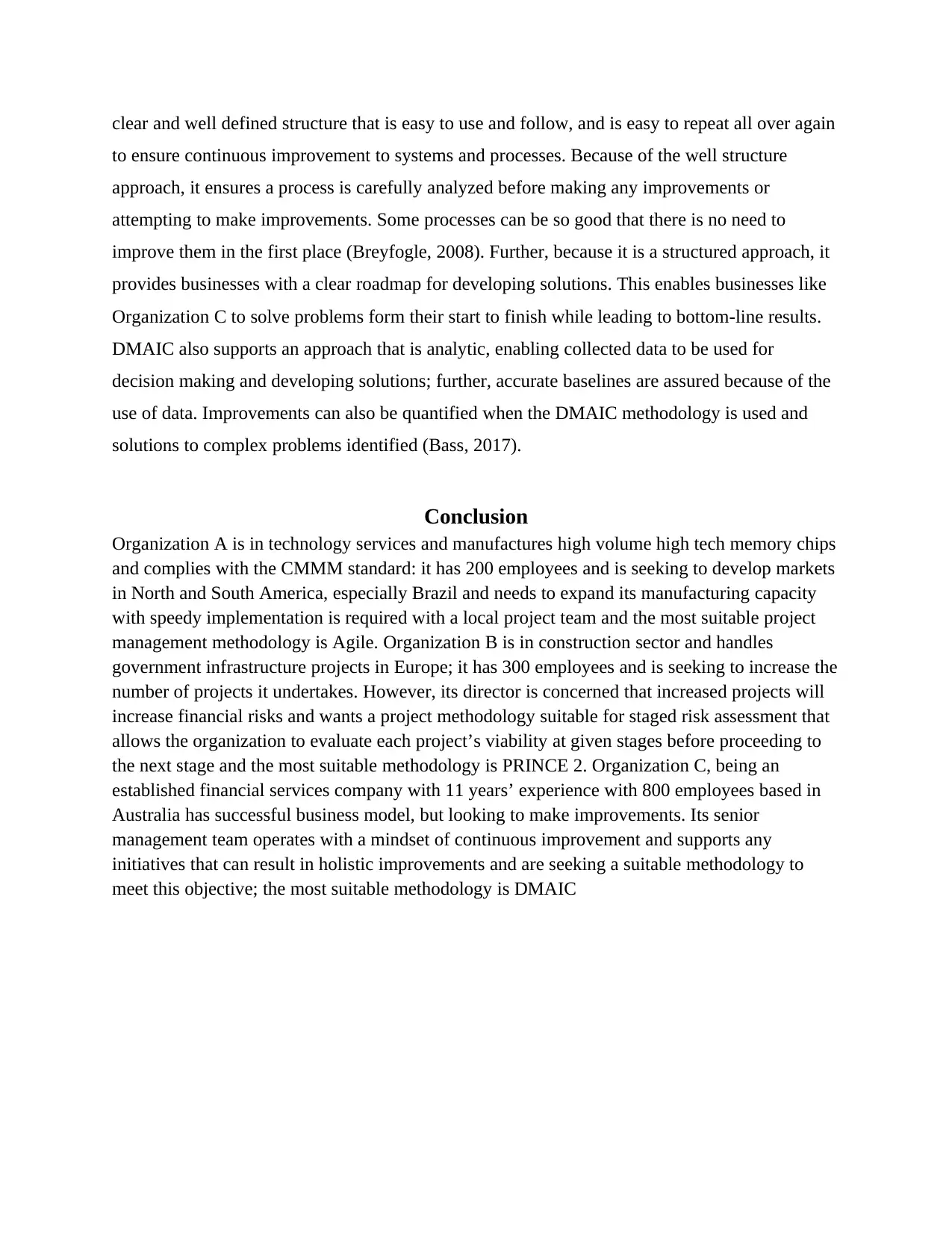
clear and well defined structure that is easy to use and follow, and is easy to repeat all over again
to ensure continuous improvement to systems and processes. Because of the well structure
approach, it ensures a process is carefully analyzed before making any improvements or
attempting to make improvements. Some processes can be so good that there is no need to
improve them in the first place (Breyfogle, 2008). Further, because it is a structured approach, it
provides businesses with a clear roadmap for developing solutions. This enables businesses like
Organization C to solve problems form their start to finish while leading to bottom-line results.
DMAIC also supports an approach that is analytic, enabling collected data to be used for
decision making and developing solutions; further, accurate baselines are assured because of the
use of data. Improvements can also be quantified when the DMAIC methodology is used and
solutions to complex problems identified (Bass, 2017).
Conclusion
Organization A is in technology services and manufactures high volume high tech memory chips
and complies with the CMMM standard: it has 200 employees and is seeking to develop markets
in North and South America, especially Brazil and needs to expand its manufacturing capacity
with speedy implementation is required with a local project team and the most suitable project
management methodology is Agile. Organization B is in construction sector and handles
government infrastructure projects in Europe; it has 300 employees and is seeking to increase the
number of projects it undertakes. However, its director is concerned that increased projects will
increase financial risks and wants a project methodology suitable for staged risk assessment that
allows the organization to evaluate each project’s viability at given stages before proceeding to
the next stage and the most suitable methodology is PRINCE 2. Organization C, being an
established financial services company with 11 years’ experience with 800 employees based in
Australia has successful business model, but looking to make improvements. Its senior
management team operates with a mindset of continuous improvement and supports any
initiatives that can result in holistic improvements and are seeking a suitable methodology to
meet this objective; the most suitable methodology is DMAIC
to ensure continuous improvement to systems and processes. Because of the well structure
approach, it ensures a process is carefully analyzed before making any improvements or
attempting to make improvements. Some processes can be so good that there is no need to
improve them in the first place (Breyfogle, 2008). Further, because it is a structured approach, it
provides businesses with a clear roadmap for developing solutions. This enables businesses like
Organization C to solve problems form their start to finish while leading to bottom-line results.
DMAIC also supports an approach that is analytic, enabling collected data to be used for
decision making and developing solutions; further, accurate baselines are assured because of the
use of data. Improvements can also be quantified when the DMAIC methodology is used and
solutions to complex problems identified (Bass, 2017).
Conclusion
Organization A is in technology services and manufactures high volume high tech memory chips
and complies with the CMMM standard: it has 200 employees and is seeking to develop markets
in North and South America, especially Brazil and needs to expand its manufacturing capacity
with speedy implementation is required with a local project team and the most suitable project
management methodology is Agile. Organization B is in construction sector and handles
government infrastructure projects in Europe; it has 300 employees and is seeking to increase the
number of projects it undertakes. However, its director is concerned that increased projects will
increase financial risks and wants a project methodology suitable for staged risk assessment that
allows the organization to evaluate each project’s viability at given stages before proceeding to
the next stage and the most suitable methodology is PRINCE 2. Organization C, being an
established financial services company with 11 years’ experience with 800 employees based in
Australia has successful business model, but looking to make improvements. Its senior
management team operates with a mindset of continuous improvement and supports any
initiatives that can result in holistic improvements and are seeking a suitable methodology to
meet this objective; the most suitable methodology is DMAIC
⊘ This is a preview!⊘
Do you want full access?
Subscribe today to unlock all pages.

Trusted by 1+ million students worldwide
1 out of 14
Related Documents
Your All-in-One AI-Powered Toolkit for Academic Success.
+13062052269
info@desklib.com
Available 24*7 on WhatsApp / Email
![[object Object]](/_next/static/media/star-bottom.7253800d.svg)
Unlock your academic potential
Copyright © 2020–2025 A2Z Services. All Rights Reserved. Developed and managed by ZUCOL.





